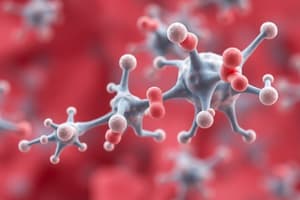Podcast
Questions and Answers
Which type of adrenergic agonists work by promotion of norepinephrine release?
Which type of adrenergic agonists work by promotion of norepinephrine release?
- Noncatacholamines
- Catecholamines
- Direct agonists
- Indirect agonists (correct)
What is the defining feature that differentiates catecholamines from noncatacholamines?
What is the defining feature that differentiates catecholamines from noncatacholamines?
- Chemical structure (correct)
- Availability for oral use
- Ability to cross the blood-brain barrier
- Duration of action
Why can't catecholamines be used orally?
Why can't catecholamines be used orally?
- They lack the necessary chemical structure for oral use
- They cannot cross the blood-brain barrier
- They are quickly metabolized by enzymes (correct)
- They have a brief duration of action
Which enzyme quickly metabolizes catecholamines?
Which enzyme quickly metabolizes catecholamines?
What is the mechanism of action for direct adrenergic agonists?
What is the mechanism of action for direct adrenergic agonists?
What class of adrenergic agonists cannot cross the blood-brain barrier?
What class of adrenergic agonists cannot cross the blood-brain barrier?
Which group contains dopamine, epinephrine, isoproterenol, and ephedrine?
Which group contains dopamine, epinephrine, isoproterenol, and ephedrine?
Which enzymes are present in the liver and in the intestinal wall?
Which enzymes are present in the liver and in the intestinal wall?
Why are catecholamines ineffective when given orally?
Why are catecholamines ineffective when given orally?
What causes the pink or brown pigmentation of catecholamine-containing solutions over time?
What causes the pink or brown pigmentation of catecholamine-containing solutions over time?
How do noncatecholamines differ from catecholamines in terms of metabolism?
How do noncatecholamines differ from catecholamines in terms of metabolism?
What allows noncatecholamines to be given orally?
What allows noncatecholamines to be given orally?
Why do noncatecholamines have longer half-lives compared to catecholamines?
Why do noncatecholamines have longer half-lives compared to catecholamines?
What makes noncatecholamines less polar than catecholamines?
What makes noncatecholamines less polar than catecholamines?
Flashcards are hidden until you start studying
Study Notes
Adrenergic Agonists
- Alpha-2 agonists work by promoting norepinephrine release.
Catecholamines
- Defining feature: presence of a catechol group (3,4-dihydroxyphenyl) in their structure.
- Cannot be used orally because they are rapidly metabolized by COMT (catechol-O-methyltransferase) and MAO (monoamine oxidase).
- COMT quickly metabolizes catecholamines.
Mechanism of Action
- Direct adrenergic agonists work by directly binding to adrenergic receptors.
Classification
- Catecholamines: dopamine, epinephrine, isoproterenol, and ephedrine.
- Noncatecholamines: cannot cross the blood-brain barrier.
Enzymes
- COMT and MAO are present in the liver and intestinal wall.
Ineffective Oral Administration
- Catecholamines are ineffective when given orally due to rapid metabolism by COMT and MAO.
Pigmentation
- Catecholamine-containing solutions turn pink or brown over time due to oxidation.
Metabolism
- Noncatecholamines differ from catecholamines in that they are not metabolized by COMT.
Oral Administration
- Noncatecholamines can be given orally because they are not rapidly metabolized by COMT and MAO.
Half-Lives
- Noncatecholamines have longer half-lives compared to catecholamines due to slower metabolism.
Polarity
- Noncatecholamines are less polar than catecholamines, making them more capable of crossing the blood-brain barrier.
Studying That Suits You
Use AI to generate personalized quizzes and flashcards to suit your learning preferences.




